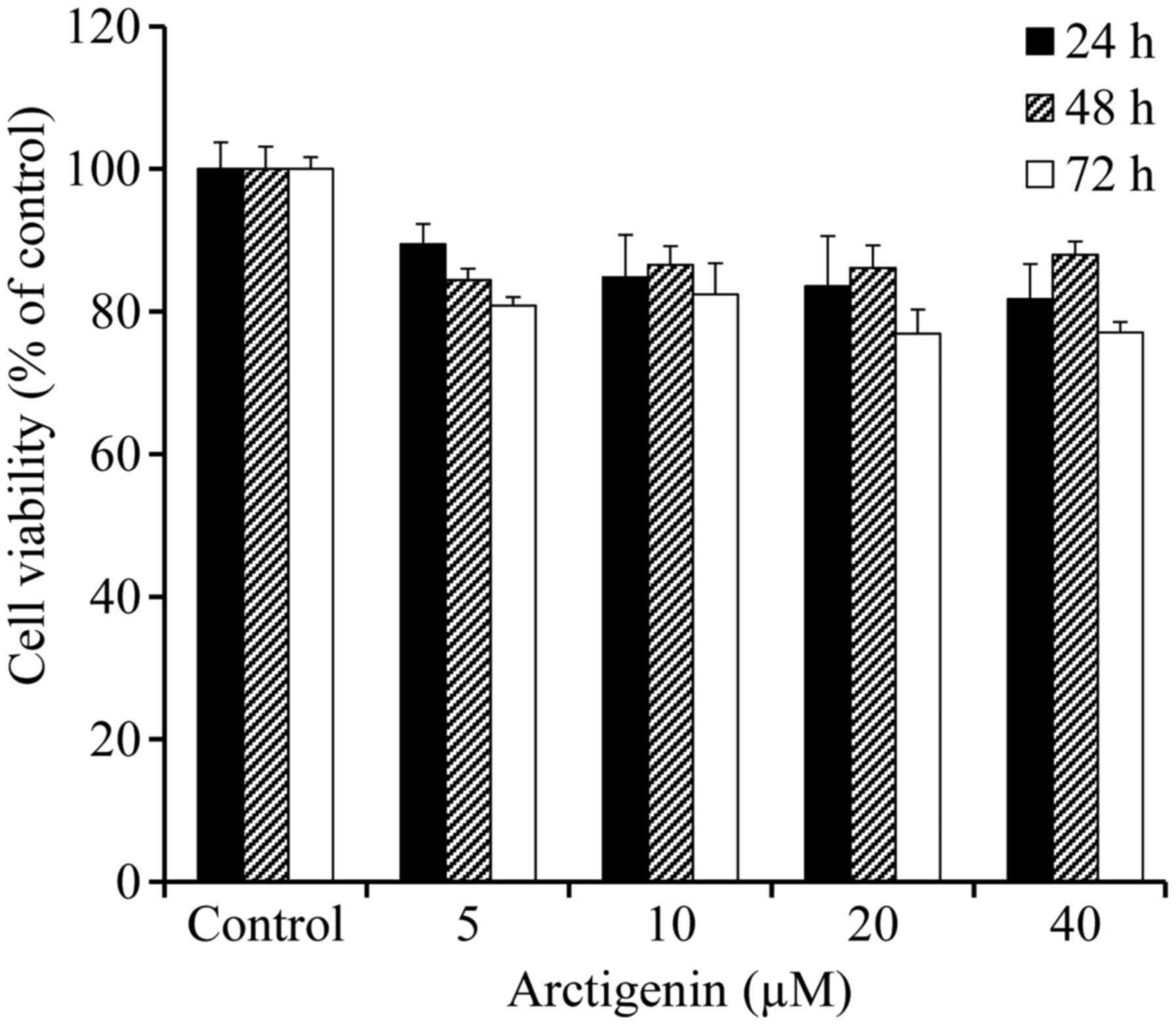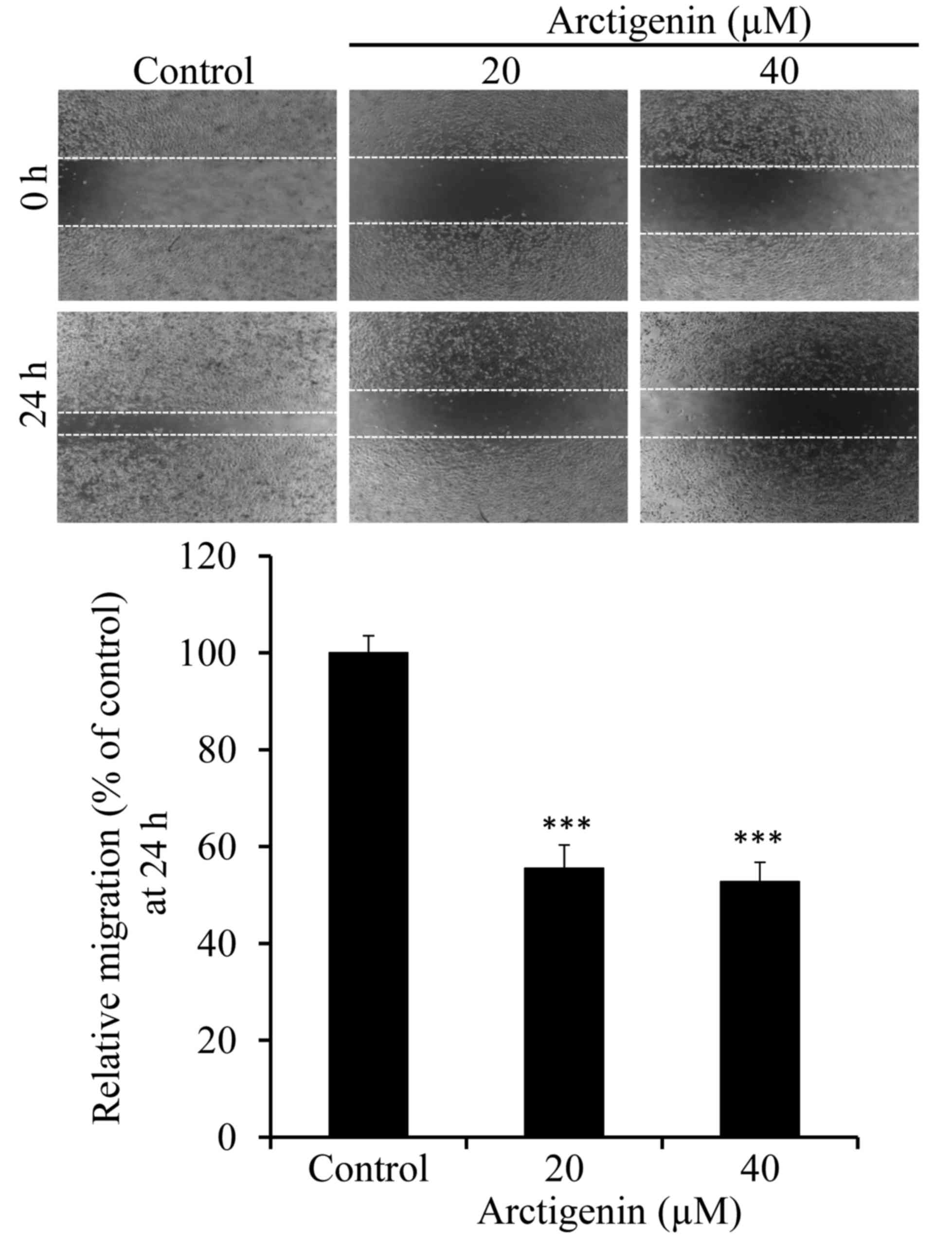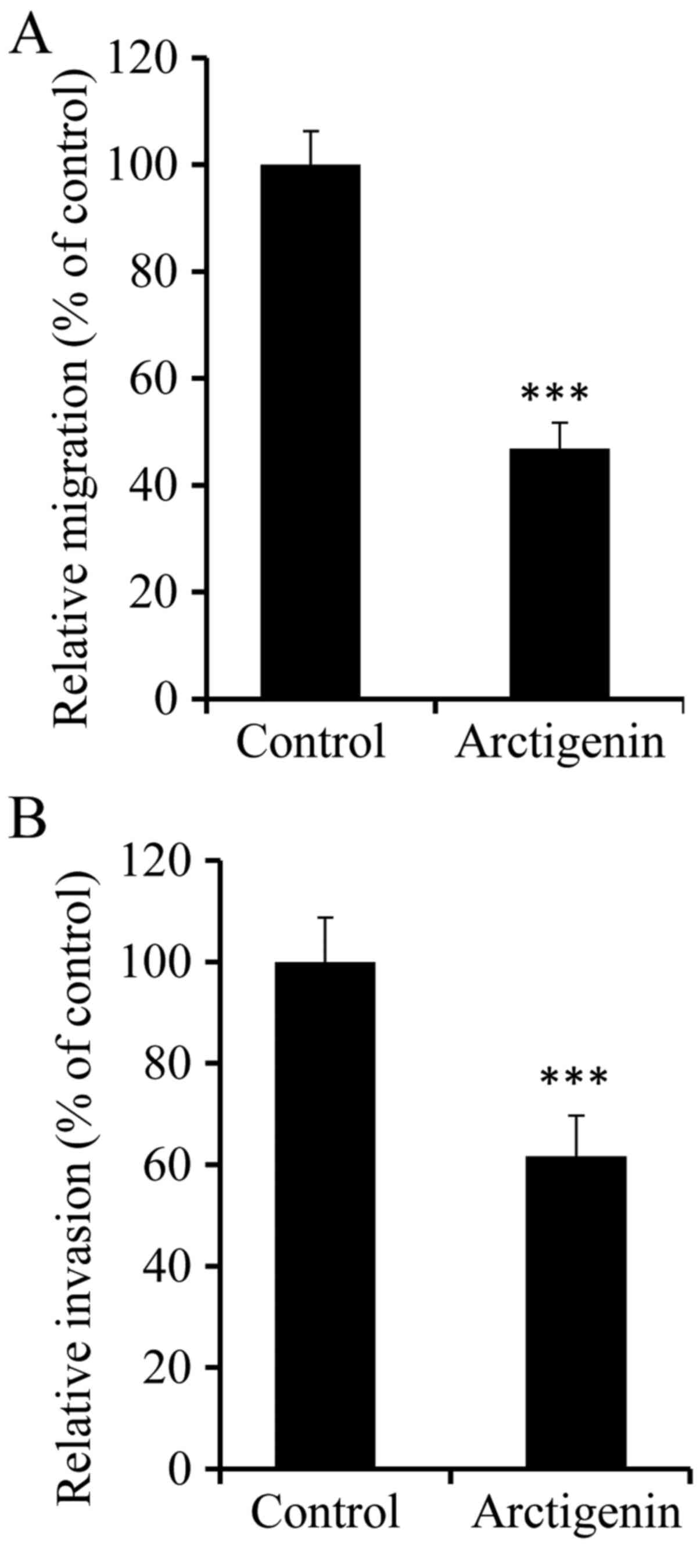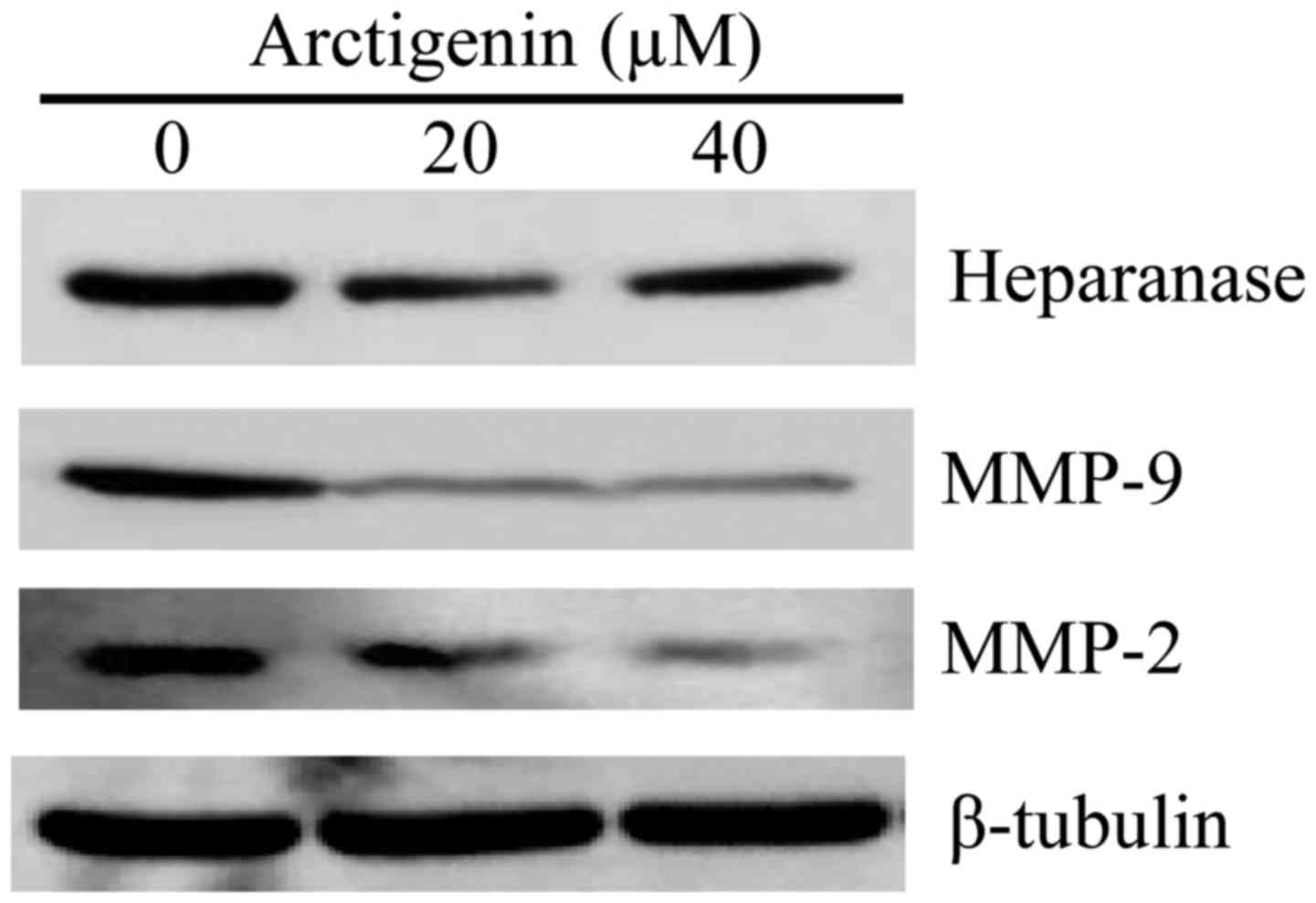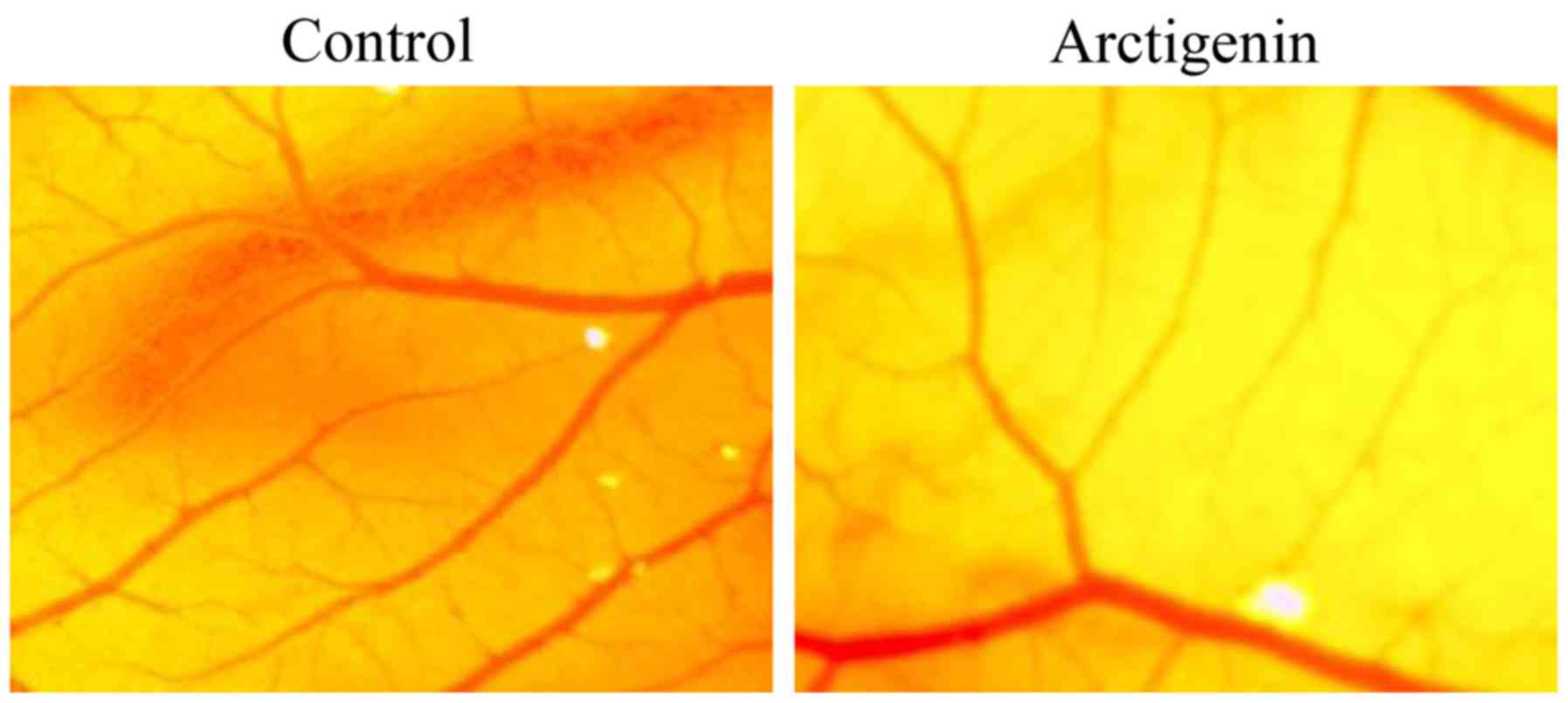Introduction
Breast cancer is the most frequently diagnosed
cancer and the leading cause of cancer-related death in females
worldwide, with an estimated 1.7 million cases and 521,900 deaths
in 2012 (1). Metastases to distant
sites are common (2). Approximately
65–75% of patients with advanced breast cancer may develop bone
metastases (3). Remarkable progress
has been made in the treatment of breast cancer. However, despite
these advances, the mortality rate is still high, mainly due to
metastatic spread (4). Therefore,
the development of new agents for breast cancer is important to
reduce the mortality caused by this disease.
Natural products are a very important source
providing promising leads for the development of novel cancer
therapeutics due to their potentially low toxicity profiles and
potential effectiveness (5).
Arctium lappa L., commonly known as burdock or bardana, is a
traditional Chinese medicine and perennial plant of the Compositae
family. Recent studies demonstrated that Arctium lappa L.
has numerous pharmacological activities, including
anti-inflammatory (6), antitumor
(7), antioxidant (8) and antiviral activities (9). However, the information concerning the
antitumor constituents in this plant is still limited.
Arctigenin is the main active constituent that is
extracted and isolated from the fruit of Arctium lappa L.
(10). Experimental studies have
shown various pharmacological effects of arctigenin including its
antitumor activity (11–14). However, the antimetastatic effects
of arctigenin on human breast cancer cells remain unknown. In the
present study, we investigated the antimetastatic effect of
arctigenin in human breast cancer cells. Results of this
investigation may provide a scientific explanation for the
antimetastatic mechanism of arctigenin.
Materials and methods
Chemicals and reagents
Arctigenin, isolated from the fruit of Arctium
lappa L., was kindly gifted by Dr Kunming Qin at Nanjing
University of Traditional Chinese Medicine, and dissolved in
dimethyl sulfoxide (DMSO) at a final concentration of 10 mM. The
purity of arctigenin was above 98% (confirmed by high performance
liquid chromatography and spectral analysis). Antibodies against
MMP-2 (#4022), MMP-9 (#13667) and β-tubulin (#2128) for western
blot analysis were obtained from Cell Signaling Technology
(Beverly, MA, USA). An antibody against heparanase (ab42817) was
obtained from Abcam (Cambridge, UK).
3-(4,5-Dimethyl-2-thiazolyl)-2,5-diphenyl-2H-tetrazolium bromide
(MTT) and DMSO were purchased from Sigma-Aldrich (St. Louis, MO,
USA). Fetal bovine serum (FBS) was purchased from BD Pharmingen
(San Diego, CA, USA).
Cell culture
The human breast cancer cell line MDA-MB-231 was
cultured in Dulbecco's modified Eagle's medium (DMEM) containing
10% FBS (both from Gibco, Carlsbad, CA, USA), 100 U/ml penicillin
G, 2.5 µg/ml amphotericin B and 100 µg/ml streptomycin (complete
medium) at 37°C with 5% CO2 in a humidified
atmosphere.
Cytotoxicity assay
The cytotoxic effect of arctigenin on MDA-MB-231
cells was evaluated by the MTT assay. Briefly, MDA-MB-231 cells
were placed into 96-well plates at a final concentration of
1×104 cells/well in complete medium. Cells were treated
with a range of concentrations of arctigenin. Twenty microliters of
MTT (5 mg/ml) were then added at 24, 48 and 72 h after treatment.
The cells were incubated for another 4 h at 37°C in the dark.
Formed formazan crystals were dissolved in 100 µl DMSO and the
absorbance was measured at 570 nm on a microplate reader (Bio-Rad,
Hercules, CA, USA).
Wound healing assay
MDA-MB-231 cells were plated into a 24-well plate at
a density of 2×105 cells/well and allowed to form a
confluent monolayer for 24 h. Subsequently, the monolayer was
scratched with a sterile pipette tip (1,000 µl), washed with medium
to remove floating and detached cells and photographed (time 0 h).
The cells were successively treated in medium in the presence of
different concentrations of arctigenin (20 and 40 µM) along with
vehicle DMSO for 24 h. Scratched areas were photographed
(magnification, ×40) at 0 h, and then subsequently again 24 h later
to assess the degree of wound healing. The percentage of wound
closure was estimated by the following equation: Wound closure % =
1 - (wound area at t24/wound area at t0) ×
100%, where t24 is the time after wounding and
t0 is the time immediately after wounding.
Boyden chamber migration and invasion
assays
MDA-MB-231 cell migration was also investigated by a
modified Boyden chamber assay. The method is based on the passage
of cells across porous filters separating the upper and lower wells
of the migration chamber. Briefly, cells were incubated in the
presence or absence of 40 µM arctigenin for 24 h. After
trypsinization, 1×105 cells suspended in 0.1% (v/v) BSA
medium were placed in the upper chamber of 8-µm pore size
Transwells (24-well; Millipore, Billerica, MA, USA) and incubated
for 18 h at 37°C under 5% CO2. For the invasion assay,
the upper surface of the Transwell membrane was coated with 1 µg
Matrigel. Cells (2×105) (incubated in the presence or
absence of 40 µM arctigenin for 24 h) in 0.1% (v/v) BSA medium were
placed in the upper part of the Transwell membrane and allowed to
migrate for another 24 h. For both the migration and invasion
assay, the unmigrated cells were removed from the upper surface of
the membrane and the migrated cells on the lower surface of the
membrane were fixed in 100% methanol and stained with hematoxylin
and eosin. The migration and invasion were determined by counting
the number of cells with a microscope at a magnification of ×100.
Five visual fields were chosen randomly and the average number of
migrating cells in the five fields was obtained for each group.
Gelatin zymography
The enzymatic activities of MMP-2 and MMP-9 were
assayed by gelatin zymography in the absence of serum (15). The culture supernatants from
compound-treated cultures were collected and centrifuged to remove
debris. Subsequently, the medium was concentrated by centrifugal
filters (Amicon® Ultra; Millipore). The conditioned
medium was then mixed with non-reducing SDS-sample buffer [62.5 mM
Tris-HCl (pH 6.8), 10% glycerol, 0.00125% bromophenol blue and 2%
SDS], and then incubated at 37°C for 30 min. The samples thus
prepared were electrophoresed on 7.5% polyacrylamide gel containing
0.1% SDS and 0.1% gelatin at 4°C. After electrophoresis, the gels
were washed twice with a rinsing buffer (50 mM Tris-HCl, 2.5%
Triton X-100, 5 mM CaCl2, 1 mM ZnCl2 and
0.05% NaN3) at room temperature for 1 h to remove the
SDS. Then, the gels were incubated with an incubation buffer (50 mM
Tris-HCl, 5 mM CaCl2, 1 mM ZnCl2 and 0.05%
NaN3) for 42 h at 37°C and stained with a staining
solution (0.1% Coomassie Brilliant Blue, 10% acetic acid and 10%
isopropanol). The locations of the gelatinolytic enzymes were
visualized as clear bands on the blue background. The bands were
scanned by an image scanner and quantified by ImageJ software.
Western blot analysis
MDA-MB-231 cells were exposed to arctigenin for 24
h. The treated cells were collected, washed with phosphate-buffered
saline (PBS), and lysed in lysis buffer [25 mM HEPES (pH 7.7), 0.3
M NaCl, 1.5 mM MgCl2, 0.2 mM EDTA, 0.1% Triton X-100, 20
mM β-glycerophosphate, 0.1 mM sodium orthovanadate, 0.5 mM
phenylemethylsulfonyl fluoride (PMSF), 1 mM dithiothreitol, 10
mg/ml aprotinin and 10 mg/ml leupeptin]. The cell lysates were
separated by 10% SDS-PAGE and transferred to PVDF membranes using a
glycine transfer buffer [192 mM glycine, 25 mM Tris-HCl (pH 8.8)
and 20% (v/v) methanol]. After blocking with Block Ace for 4 h at
room temperature, the membrane was incubated overnight with primary
antibodies, and then for 60 min with secondary antibodies. The
primary antibodies were used at a dilution of 1:1,000. The
secondary antibodies were used at a dilution of 1:2,000 and
visualized with an enhanced chemiluminescence system (Bio-Rad).
Chick embryo chorioallantoic membrane
(CAM) assay
The in vivo antiangiogenic activity of
arctigenin was evaluated by a CAM assay. Briefly, fertilized
chicken eggs were incubated at 37°C with 55–60% humidity. After
incubation for seven days, a 2 cm2 window was opened at
the blunt end of the eggs and the shell membrane was removed to
expose the CAM. Then, a sterilized 5 mm diameter gelfoam used as a
drug carrier that absorbed 10 µl arctigenin (50 µM) was placed on
the CAM. The window was sealed with parafilm and the egg was
returned to the incubator for an additional two days with the
window upright. Subsequently, the CAM microvessels were observed
and photographed with a digital camera (Nikon, Tokyo, Japan).
Statistical analysis
All data are expressed as the mean ± SD of at least
three independent experiments, and the statistical analysis for
single comparison was evaluated by performing a Student's t-test.
The criterion of statistical significance was p<0.05, p<0.01,
p<0.001.
Results
Effects of arctigenin on MDA-MB-231
cell viability
The MTT assay was used as an indirect measure to
determine the viability of the MDA-MB-231 cells exposed to
arctigenin. The MDA-MB-231 cells were treated with arctigenin for
24 h at various concentrations (0–40 µM). As shown in Fig. 1, arctigenin at a concentration below
40 µM showed little effect on the viability of the MDA-MB-231
cells. The cell viability at 24 h was decreased to 89.45±2.85,
84.81±5.96, 83.57±7.02 and 81.77±4.88% compared to the control when
the concentration of arctigenin was 5, 10, 20 and 40 µM,
respectively. Therefore, these concentrations were selected for
further evaluation of the anti-invasion and anti-migration effects
of arctigenin.
Arctigenin suppresses migration of
MDA-MB-231 cancer cells in vitro
To determine whether arctigenin could suppress the
migration of MDA-MB-231 cancer cells, mechanical wounds were
introduced into confluent monolayers, and wound closure was
measured by microscopy. As shown in Fig. 2, arctigenin inhibited wound closure
in a dose-dependent manner. When cells were treated with 20 and 40
µM arctigenin (Fig. 2), compared to
the control group, the wound closure rate was decreased to
55.56±4.78 and 52.78±3.99%, respectively. Furthermore, a Boyden
chamber migration assay also demonstrated the anti-migratory effect
of arctigenin. As shown in Fig. 3A,
following the treatment of arctigenin (40 µM), the migration rate
was decreased to 46.88±4.79%. These results suggest that arctigenin
is effective in decreasing the migration of the MDA-MB-231
cells.
Arctigenin suppresses invasion of
MDA-MB-231 cancer cells in vitro
To further confirm the activity of arctigenin on
cell invasion, a Boyden chamber invasion assay was performed to
evaluate the anti-invasion effect of arctigenin on MDA-MB-231
cells. As shown in Fig. 3B, the
results showed that arctigenin significantly inhibited cell
invasion. After treatment with 40 µM of arctigenin, compared to the
control group, the invasion rate of the MDA-MB-231 cells through
the Matrigel was decreased to 61.70±7.96%. These results suggest
that arctigenin is effective in decreasing MDA-MB-231 cell
invasion.
Arctigenin suppresses MMP-2 and MMP-9
enzyme activity in MDA-MB-231 cells
To determine whether the inhibitory effect of
arctigenin on the invasion of MDA-MB-231 cells was related to the
activity of MMPs, a gelatin zymography assay was performed to
examine the activity of MMP-2 and MMP-9. As shown in Fig. 4, arctigenin-treated MDA-MB-231 cells
showed a decrease in the activity of both MMP-2 and MMP-9. When the
cells were treated with 20 and 40 µM arctigenin (Fig. 4), compared to the control group, the
mean activity of MMP-9 was decreased to 43.05±4.70 and 25.05±4.11%,
and the activity of MMP-2 was decreased to 58.89±9.11 and
19.06±5.10%, respectively. These results demonstrated that the
decrease of the enzymatic activity of MMP-2 and MMP-9 proteins
secreted from the MDA-MB-231 cells was related to the
antimetastatic effect of arctigenin.
Arctigenin downregulates MMP-2, MMP-9
and heparanase protein expression in MDA-MB-231 cells
Degradation of extracellular matrix (ECM) proteins
is an essential step in the invasion and metastasis of cancer cells
and is mainly mediated by MMPs such as MMP-2 and MMP-9 (16). To test whether arctigenin suppresses
cancer cell invasion and motility by affecting the expression of
matrix metalloproteinases, a western blot analysis assay was
performed to examine the expression of MMP-2 and MMP-9 in cancer
cells after treatment with arctigenin. As shown in Fig. 5, the expression level of MMP-2 and
MMP-9 was significantly downregulated. Heparanase, an
endoglycosidase, mediates tumor invasion primarily through the
direct cleavage of the heparan sulfate proteoglycan in the ECM
(17,18). Recent studies have demonstrated that
heparanase plays an important role in tumor metastases (19). In the present study, the effect of
arctigenin on heparanase protein expression in MDA-MB-231 cells was
also investigated. As shown in Fig.
5, the expression level of heparanase was significantly
downregulated following arctigenin treatment.
Arctigenin inhibits angiogenesis in
CAM assay
The CAM assay is the method commonly used for
screening anti-angiogenic drugs and studying angiogenic mechanisms
in vivo (20). To the best
of our knowledge, angiogenesis is required for invasive tumor
growth and metastasis and constitutes an important point in the
control of cancer progression (21). Its inhibition may be a valuable new
approach to cancer therapy. Therefore, the chick embryo CAM assay
was performed to further evaluate the inhibitory effect of
arctigenin on in vivo angiogenesis. Results showed that the
formation of new blood vessels was significantly inhibited in
arctigenin-treated CAM compared to that in the control (Fig. 6). These results suggest that the
anti-angiogenic activity may be one of the antimetastatic
mechanisms of arctigenin against breast cancer cells.
Discussion
Metastasis, the spread of malignant cells from a
primary tumor to distant sites, poses the biggest problem to cancer
treatment and is the main cause of death of cancer patients
(22). The mortality rate due to
metastatic cancer has been observed to be >90% when compared to
the rate attributed to the primary tumors from which the malignant
lesions arise (23). Natural
products are a very important source providing promising leads for
the development of novel cancer therapeutics (5), and a number of them are known for
their antimetastatic activity in cancer cells (15,24,25).
Arctium lappa L., a traditional Chinese medicine and
perennial plant of the Compositae family, is one of these plants
which has been attracting much attention recently due to its proven
antitumor effects (7,14,26).
Arctigenin is one of the main active constituents in Arctium
lappa L. Experimental studies have demonstrated its antitumor
effects on various cancer cells (27–29).
However, the antimetastatic effects of arctigenin on cancer cells
remain unknown. In the present study, we investigated the
antimetastatic effect of arctigenin on human breast cancer cells.
The present study demonstrated that arctigenin significantly
suppressed the migration in vitro both through wound healing
(Fig. 2) and Boyden chamber
migration assay (Fig. 3A).
Furthermore, the results of the Boyden chamber invasion assay also
demonstrated the inhibitory effect of arctigenin on the invasion of
MDA-MB-231 cancer cells.
Matrix metalloproteinases (MMPs), a family of
structurally and functionally related zinc-dependent enzymes,
significantly contribute to the promotion of metastasis and tumor
growth and the mechanisms include proteolytic degradation of ECM
components and possibly regulation of tumor cell growth itself
(30–32). Among the MMPs, MMP-2 and MMP-9 are
involved in facilitating cancer metastasis (33,34).
To determine whether the inhibitory effect of arctigenin on the
invasion of MDA-MB-231 cells is related to the activity of MMPs,
gelatin zymography and western blot analysis assays were performed
to examine the activity of MMP-2 and MMP-9 in MDA-MB-231 cells.
Consistent with the aforementioned notions, the results showed that
with arctigenin treatment the activity and expression of MMP-2 and
MMP-9 was markedly inhibited (Figs.
4 and 5). These results
indicated that arctigenin suppressed cell metastasis by inhibiting
the activities of MMPs.
Heparanase, an endo-β-D-glucuronidase, has the
ability to cleave heparin sulfate (HS) chains of heparan sulfate
proteoglycans (HSPGs) in the extracellular matrix (ECM) and
basement membrane (BM) and plays a critical role in tumor cell
invasion, migration and angiogenesis (35). Previous studies have reported the
possible mechanisms involving the coordinated actions of MMP-9 and
heparanase. Enhanced expression of heparanase promoted the
phosphorylation of Akt and Src, following facilitation of gene
transcription like VEGF or the promotion of the upregulation of
uPA. After activating these signaling molecules, the level of MMP-9
was eventually increased (36,37).
Notably, in the present study, after treatment with arctigenin, the
expression of heparanase was significantly downregulated. These
results could provide an experimental base to explore the
coordinated actions of MMPs and heparanase in breast cancer
metastasis.
As it is widely known, tumor cell invasion alone is
not sufficient to produce distant metastasis; it requires the
transport of malignant cells through the blood and/or lymph
vessels. Angiogenesis is a crucial factor in tumor growth and
metastases and constitutes an important point in the control of
cancer progression (21). Its
inhibition may be a valuable new approach to cancer therapy. A high
level of tumor angiogenic activity often results in rich metastases
and poor prognosis. In the present study, arctigenin evidently
inhibited the formation of capillaries compared with saline-treated
embryos using the chick embryo chorioallantoic membrane assay,
indicating the anti-angiogenic effects of arctigenin in
vivo. These results suggested that the anti-angiogenic activity
may be one of the antimetastatic mechanisms of arctigenin against
breast cancer cells.
In conclusion, the authors demonstrated that
arctigenin suppressed the metastasis of MDA-MB-231 cancer cells by
downregulation of MMP-2, MMP-9 and heparanase. However, more
studies are still required to determine the exact mechanisms
involved and to explore signal transduction pathways to better
understand the biological mechanisms.
Acknowledgements
The present study was kindly supported by the
Zhejiang Chinese Medical University Research Fund Project
(2015ZR06), the Zhejiang Provincial Natural Science Fund
(LZ15H310001), and the Open Project of First-Class Key Discipline
for Science of Chinese Materia Medica, Zhejiang Chinese Medical
University (Yao2016017).
References
|
1
|
Torre LA, Bray F, Siegel RL, Ferlay J,
Lortet-Tieulent J and Jemal A: Global cancer statistics, 2012. CA
Cancer J Clin. 65:87–108. 2015. View Article : Google Scholar : PubMed/NCBI
|
|
2
|
Louie E, Chen XF, Coomes A, Ji K, Tsirka S
and Chen EI: Neurotrophin-3 modulates breast cancer cells and the
microenvironment to promote the growth of breast cancer brain
metastasis. Oncogene. 32:4064–4077. 2013. View Article : Google Scholar : PubMed/NCBI
|
|
3
|
Coleman RE: Metastatic bone disease:
Clinical features, pathophysiology and treatment strategies. Cancer
Treat Rev. 27:165–176. 2001. View Article : Google Scholar : PubMed/NCBI
|
|
4
|
Mann J: Natural products in cancer
chemotherapy: Past, present and future. Nat Rev Cancer. 2:143–148.
2002. View
Article : Google Scholar : PubMed/NCBI
|
|
5
|
Crowell JA: The chemopreventive agent
development research program in the Division of Cancer Prevention
of the US National Cancer Institute: An overview. Eur J Cancer.
41:1889–1910. 2005. View Article : Google Scholar : PubMed/NCBI
|
|
6
|
Knipping K, van Esch EC, Wijering SC, van
der Heide S, Dubois AE and Garssen J: In vitro and in vivo
anti-allergic effects of Arctium lappa L. Exp Biol Med.
233:1469–1477. 2008. View Article : Google Scholar
|
|
7
|
Sun Q, Liu K, Shen X, Jin W, Jiang L,
Sheikh MS, Hu Y and Huang Y: Lappaol F, a novel anticancer agent
isolated from plant Arctium lappa L. Mol Cancer Ther. 13:49–59.
2014. View Article : Google Scholar : PubMed/NCBI
|
|
8
|
Wang Z, Li P and Wang C, Jiang Q, Zhang L,
Cao Y, Zhong W and Wang C: Protective effects of Arctium lappa L.
root extracts (AREs) on high fat diet induced quail
atherosclerosis. BMC Complement Altern Med. 16:62016.
|
|
9
|
Herrmann F, Romero MR, Blazquez AG,
Kaufmann D, Ashour ML, Kahl S, Marin JJG, Efferth T and Wink M:
Diversity of pharmacological properties in Chinese and European
medicinal plants: Cytotoxicity, antiviral and antitrypanosomal
screening of 82 herbal drugs. Diversity. 3:547–580. 2011.
View Article : Google Scholar
|
|
10
|
Cho MK, Jang YP, Kim YC and Kim SG:
Arctigenin, a phenylpropanoid dibenzylbutyrolactone lignan,
inhibits MAP kinases and AP-1 activation via potent MKK inhibition:
The role in TNF-alpha inhibition. Int Immunopharmacol. 4:1419–1429.
2004. View Article : Google Scholar : PubMed/NCBI
|
|
11
|
Zhang WZ, Jiang ZK, He BX and Liu XB:
Arctigenin protects against lipopolysaccharide-induced pulmonary
oxidative stress and inflammation in a mouse model via suppression
of MAPK, HO-1, and iNOS signaling. Inflammation. 38:1406–1414.
2015. View Article : Google Scholar : PubMed/NCBI
|
|
12
|
Li W, Zhang Z, Zhang K, Xue Z, Li Y, Zhang
Z, Zhang L, Gu C, Zhang Q, Hao J, et al: Arctigenin suppress Th17
cells and ameliorates experimental autoimmune encephalomyelitis
through AMPK and PPAR-gamma/ROR-gammat signaling. Mol Neurobiol.
53:5356–5366. 2016. View Article : Google Scholar : PubMed/NCBI
|
|
13
|
Hayashi K, Narutaki K, Nagaoka Y, Hayashi
T and Uesato S: Therapeutic effect of arctiin and arctigenin in
immunocompetent and immunocompromised mice infected with influenza
A virus. Biol Pharm Bull. 33:1199–1205. 2010. View Article : Google Scholar : PubMed/NCBI
|
|
14
|
Susanti S, Iwasaki H, Itokazu Y, Nago M,
Taira N, Saitoh S and Oku H: Tumor specific cytotoxicity of
arctigenin isolated from herbal plant Arctium lappa L. J Nat Med.
66:614–621. 2012. View Article : Google Scholar : PubMed/NCBI
|
|
15
|
Lou C, Takahashi K, Irimura T, Saiki I and
Hayakawa Y: Identification of Hirsutine as an anti-metastatic
phytochemical by targeting NF-κB activation. Int J Oncol.
45:2085–2091. 2014.PubMed/NCBI
|
|
16
|
El-Rifai W and Powell SM: Molecular
biology of gastric cancer. Semin Radiat Oncol. 12:128–140. 2002.
View Article : Google Scholar : PubMed/NCBI
|
|
17
|
Li ZH and Yang SM: Research advancement on
heparanase in tumor metastasis. Ai Zheng. 24:1156–1160. 2005.(In
Chinese). PubMed/NCBI
|
|
18
|
Ilan N, Elkin M and Vlodavsky I:
Regulation, function and clinical significance of heparanase in
cancer metastasis and angiogenesis. Int J Biochem Cell Biol.
38:2018–2039. 2006. View Article : Google Scholar : PubMed/NCBI
|
|
19
|
Hoffmann AC, Mori R, Vallbohmer D,
Brabender J, Drebber U, Baldus SE, Klein E, Azuma M, Metzger R,
Hoffmann C, et al: High expression of heparanase is significantly
associated with dedifferentiation and lymph node metastasis in
patients with pancreatic ductal adenocarcinomas and correlated to
PDGFA and via HIF1a to HB-EGF and bFGF. J Gastrointest Surg.
12:1674–1682. 2008. View Article : Google Scholar : PubMed/NCBI
|
|
20
|
Ribatti D: Chick embryo chorioallantoic
membrane as a useful tool to study angiogenesis. Int Rev Cell Mol
Biol. 270:181–224. 2008. View Article : Google Scholar : PubMed/NCBI
|
|
21
|
Folkman J: Role of angiogenesis in tumor
growth and metastasis. Semin Oncol. 29:(Suppl 16). S15–S18. 2002.
View Article : Google Scholar
|
|
22
|
Geiger TR and Peeper DS: Metastasis
mechanisms. Biochim Biophys Acta. 1796:293–308. 2009.PubMed/NCBI
|
|
23
|
Gupta GP and Massagué J: Cancer
metastasis: Building a framework. Cell. 127:679–695. 2006.
View Article : Google Scholar : PubMed/NCBI
|
|
24
|
Meadows GG: Diet, nutrients,
phytochemicals, and cancer metastasis suppressor genes. Cancer
Metastasis Rev. 31:441–454. 2012. View Article : Google Scholar : PubMed/NCBI
|
|
25
|
Sani IK, Marashi SH and Kalalinia F:
Solamargine inhibits migration and invasion of human hepatocellular
carcinoma cells through down-regulation of matrix
metalloproteinases 2 and 9 expression and activity. Toxicol In
Vitro. 29:893–900. 2015. View Article : Google Scholar : PubMed/NCBI
|
|
26
|
Machado FB, Yamamoto RE, Zanoli K, Nocchi
SR, Novello CR, Schuquel IT, Sakuragui CM, Luftmann H,
Ueda-Nakamura T, Nakamura CV, et al: Evaluation of the
antiproliferative activity of the leaves from Arctium lappa by a
bioassay-guided fractionation. Molecules. 17:1852–1859. 2012.
View Article : Google Scholar : PubMed/NCBI
|
|
27
|
Li QC, Liang Y, Tian Y and Hu GR:
Arctigenin induces apoptosis in colon cancer cells through
ROS/p38MAPK pathway. J BUON. 21:87–94. 2016.PubMed/NCBI
|
|
28
|
Wang P, Phan T, Gordon D, Chung S, Henning
SM and Vadgama JV: Arctigenin in combination with quercetin
synergistically enhances the antiproliferative effect in prostate
cancer cells. Mol Nutr Food Res. 59:250–261. 2015. View Article : Google Scholar : PubMed/NCBI
|
|
29
|
Huang K, Li LA, Meng YG, You YQ, Fu XY and
Song L: Arctigenin promotes apoptosis in ovarian cancer cells via
the iNOS/NO/STAT3/survivin signalling. Basic Clin Pharmacol
Toxicol. 115:507–511. 2014. View Article : Google Scholar : PubMed/NCBI
|
|
30
|
Zheng H, Takahashi H, Murai Y, Cui Z,
Nomoto K, Niwa H, Tsuneyama K and Takano Y: Expressions of MMP-2,
MMP-9 and VEGF are closely linked to growth, invasion, metastasis
and angiogenesis of gastric carcinoma. Anticancer Res.
26:3579–3583. 2006.PubMed/NCBI
|
|
31
|
Bae MJ, Karadeniz F, Lee SG, Seo Y and
Kong CS: Inhibition of MMP-2 and MMP-9 activities by Limonium
tetragonum extract. Prev Nutr Food Sci. 21:38–43. 2016. View Article : Google Scholar : PubMed/NCBI
|
|
32
|
Chandler S, Miller KM, Clements JM, Lury
J, Corkill D, Anthony DC, Adams SE and Gearing AJ: Matrix
metalloproteinases, tumor necrosis factor and multiple sclerosis:
An overview. J Neuroimmunol. 72:155–161. 1997. View Article : Google Scholar : PubMed/NCBI
|
|
33
|
Overall CM and López-Otín C: Strategies
for MMP inhibition in cancer: Innovations for the post-trial era.
Nat Rev Cancer. 2:657–672. 2002. View
Article : Google Scholar : PubMed/NCBI
|
|
34
|
Kong CS, Kim YA, Kim MM, Park JS, Kim JA,
Kim SK, Lee BJ, Nam TJ and Seo Y: Flavonoid glycosides isolated
from Salicornia herbacea inhibit matrix metalloproteinase in HT1080
cells. Toxicol In Vitro. 22:1742–1748. 2008. View Article : Google Scholar : PubMed/NCBI
|
|
35
|
Shteingauz A, Boyango I, Naroditsky I,
Hammond E, Gruber M, Doweck I, Ilan N and Vlodavsky I: Heparanase
enhances tumor growth and chemoresistance by promoting autophagy.
Cancer Res. 75:3946–3957. 2015. View Article : Google Scholar : PubMed/NCBI
|
|
36
|
Tang D, Piao Y, Zhao S, Mu X, Li S, Ma W,
Song Y, Wang J, Zhao W and Zhang Q: Expression and correlation of
matrix metalloproteinase-9 and heparanase in patients with breast
cancer. Med Oncol. 31:262014. View Article : Google Scholar : PubMed/NCBI
|
|
37
|
Chen Y, Chen Y, Huang L and Yu J:
Evaluation of heparanase and matrix metalloproteinase-9 in patients
with cutaneous malignant melanoma. J Dermatol. 39:339–343. 2012.
View Article : Google Scholar : PubMed/NCBI
|















